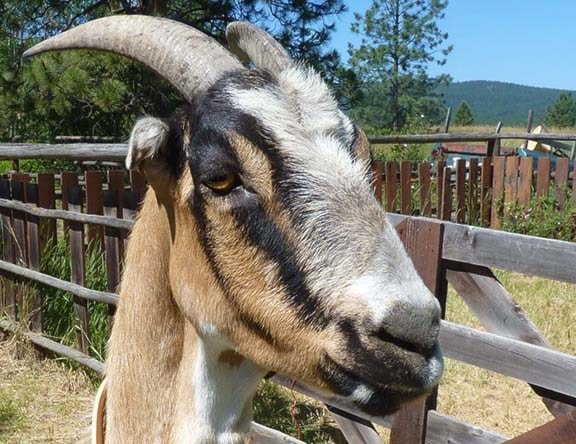Arne Petryshen
For almost a month, goats have been grazing Aq'am lands in an effort to mitigate the effects of invasive species. The project began in mid-June and will continue until July 15.
The goats are used to target invasive plants, notably Sulfur Cinquefoil on the St. Mary's lands, while leaving native plant to flourish.
Conrad Lindblom, along with his wife Donna, owns the company doing the work — Rocky Ridge Vegetation Control out of Kamloops.
"We brought down 300 goats and we're doing the vegetation control," Lindblom said. "We're controlling the invasive weeds here on the Band's land."
While the project is new to Aq'am, Lindblom and his wife have specialized in this type of invasive targeted grazing for 17 years. It is their fourth year in Kamloops.
Lindblom said the goats are just as effective at controlling the weeds as chemicals, but the goats have the benefit of being heathy for the surrounding ecosystem.
 Pictured: Sulphur cinquefoil
Pictured: Sulphur cinquefoil
"We've come up with this method of controlling invasive weeds without these herbicides," he said. "So there's absolutely no reason to use herbicides."
The current project targets Sulphur Cinquefoil, which is a introduced species that originates from the Eastern Mediterranean.
"We're restoring the grasslands for the Band; the grasslands are mostly native plants, except for this invasive weed — the Sulphur Cinquefoil. So the goats are just targeting the Sulphur Cinquefoil, not eating the native plants."
Lindblom said once the goats eat up the invasive plants, the native plants will thrive.
He said goats are a much better choice for the job than cattle, as cattle are not selective in what they eat and — because of their digestive system — actually make things worse.
"Once they eat the weeds, the weeds just go through them and they fertilize them and they spread the weeds," he said. "Whereas goats have 100 per cent digestion and they won't spread the weeds. And since we have them trained and controlled, they are just going to eat the weeds and not the native plants, so the native plants are going to come back stronger."
Lindblom said they can cover about 1,000 acres in a month. The grazing also works best if done for a couple years in a row to eradicate the invasive weeds, because of the seeds that are already in the soil.
"Once we've grazed an area for two, three years — depending on the weed we're targeting — we can get over 95 per cent of the weeds under control," he said.
While the goats only eat invasive species in the grasslands, it is not all they eat. Lindblom said they let the goats graze for about five or six hours a day on the invasive diet then bring them in and allow them to eat other things to keep their diet mixed.
They lead the goats along with saddle horses and dogs, but once they have the grazing pattern established after two or three days, the goats remember where to go.
"Then they basically know how to maneuver around and go from one clump of weeds to the next," he said. "We follow them around and make sure they are eating the right things. This is a technique we've developed over the past 17 years."
The grazing here is in it's last few days, ending July 15, that means they are working to clean up the last few areas of plants and will also be doing some smaller areas in yards. In those areas they will only use a fraction of the herd.
Lindblom said the reception has been great over the month .
"We've had lots of people drop in to see our goats and stop in and talk to us," he said. "Everywhere we go we get a lot of positive attention, because nobody wants to use herbicide."
In Kamloops, Lindblom's goats graze the city parks for invasive weeds, noting that the City of Kamloops made it public that the weed control with goats is actually 30 per cent cheaper than using herbicides.
"There is no reason to use herbicides," he said. "What we need is more herds of goats. That's what we're trying to promote. We're actually training people on how to use goats — the more people that do it the better."
They have also worked on ski hills to clear vegetation, such as willows that pop out of the snow in the winter, and on wetlands restoration. The goats can also be used to improve cattle pastures by eliminating the invasive weeds.
He also noted that there is a high demand for goat meat.
"So it's a win-win for everybody," he said.
For more information on the goats, contact Conrad and Donna Lindblom at 780-380-3061 or by email at lindblomdonna@gmail.com
